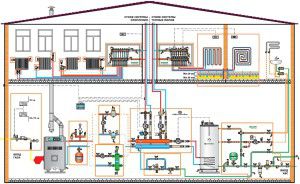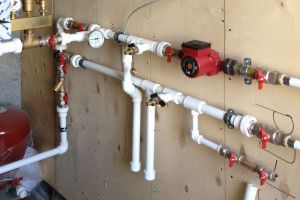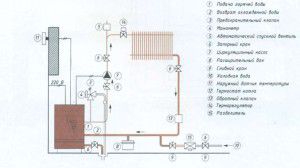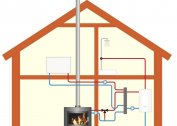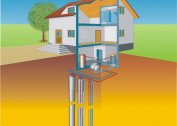Self-installation of the heating system at home should be carried out only in accordance with the rules and recommendations. To read them, you should carefully read SNiP 3.05.01-85. But besides it, there are installation features that depend on the design and material of the manufacture of heat supply components. And then the question of how to properly conduct heating in a private house with your own hands can be solved without outside help.
General rules for installing heating pipes
Installation of heating is carried out only according to a pre-compiled scheme. It indicates the location of the components, their main characteristics and quantity. But in addition to this, before properly heating the house, it is necessary to study the requirements for this type of work.
The determining criterion in deciding the installation of heat supply is the material for the manufacture of pipelines. How to conduct water heating in a private house without knowing the specifics of the operation of plastic or steel highways? For polymer products, it is necessary to take into account the temperature regime of the system, as well as pressure indicators. During the installation of steel pipelines, special attention is paid to the fastening of highways and the connection of individual lines into a single system.
Since it is possible to conduct heating in the house with your own hands only after analyzing all the above factors, experts identify the main requirements for this process:
- Gravity system - obligatory slope of pipelines of 5 mm for every 1 m. highways.
- When passing through walls, ceiling or floor, use mounting sleeves. Since heating to the second floor can only be through the ceiling - it should be protected from possible thermal effects.
- Pipe connection is carried out only using special technology. For steel lines, arc welding or mounting on threaded couplings is possible. Plastic fasten after temperature exposure, on glue (very rarely) or using compression fittings.
The optimal fastening step directly depends on the material of the pipeline production. How to hold heating pipes and fix them correctly? For steel lines with a diameter of 25 to 40 mm, it is recommended to install fastenings every 0.3 m.p. Plastic pipelines are fastened in increments of 0.2-0.25 m.
Properly conduct heating in the country with your own hands after analyzing the condition of the walls. The possibility of concealed or open installation depends on this.
Open installation of highways
The most popular way to install pipelines in a heating system is through open installation. Thus, you can quickly and efficiently conduct heating yourself. But even for this method, there are rules.
First of all, it is necessary to draw up a layout of highways. The best option is the correct wiring of the heating in the house along the walls. If the system is gravitational, the required angle of inclination is taken into account.
The basic rules for open installation are as follows:
- Distance to floor. The material of the decorative flooring is taken into account. You can conduct water heating in a private house with flooring from parquet, linoleum or a conventional board. The minimum distance from pipes to the floor should be 3-4 cm. This is necessary not only to maintain coverage, but also for the convenience of repair or maintenance work with heating.
- Distance between feed and return pipe. It should be at least 5cm. Otherwise, additional heat loss will occur and there may be difficulty in replacing damaged areas.
- Boiler connections. The temperature of the water is taken into account. How to heat from a boiler with polypropylene pipes? To do this, it is necessary to install steel pipes from the boiler, the length of which should be at least 1 m.
During heating in the house with your own hands, it is possible that the pipes will be exposed to negative temperatures. Most often this occurs in those areas that are not located in residential premises or outside the house.
To prevent the appearance of ice plugs, pipes must be insulated. There are several ways to maintain a minimum temperature on the surface of highways:
- Insulation Installation. It should not change its properties at high temperatures. It is best to use special boxes of mineral wool for this.
- Heating cable. It works on the principle of a resistive effect. When electricity passes through one of the cores, the electrical energy is transformed into heat.
During the heating to the second floor, the optimal location for the through hole is determined. It should not be in load-bearing structures (beams, load-bearing plates, etc.).
To reduce the hydraulic resistance before conducting heating pipes, a minimum number of rotary nodes should be provided in the circuit. This will also affect the complexity of installation.
Closed pipe installation
The open arrangement of highways may not be combined with the interior of the room or the whole house as a whole. To solve this issue, you can conduct heating yourself in a hidden way.
There are several ways to install pipes using this method. Do-it-yourself heating can be done under the floor or in the walls. However, in any case, the characteristics of the material of manufacture are taken into account. To install highways in the floor, a rough surface is preliminarily prepared. It should be smooth, without sudden changes in level. After laying the pipes, a concrete screed is poured.
There are two ways to install highways into walls - in gates or by closing pipelines with false panels. The first technique for proper heating in the house is to cut grooves in the walls. They are necessary for installing pipes. After the final installation, the gates are closed using cement mortar or a similar building material.
For a hidden installation of water heating in a private house, you will need to fulfill the following conditions:
- It is forbidden to make strobes in the bearing walls. This may affect the integrity of the entire building.
- During the heat supply in the house, the location of the pipes is taken into account with their own hands. It must be either vertical or horizontal. Diagonal mounting is not permitted. The same applies to the strob.
- The depth of the grooves should be 1-1.5 cm greater than the diameter of the pipes.
- When conducting heat supply to the second floor and in critical sections of the highway, inspection hatches are equipped to inspect the state of the system.
One way to hide the heating circuit is to install a water floor. It is mounted on a rough surface and then poured with a concrete screed. An alternative is to install a log on which a decorative floor is mounted.
So you can ensure uniform heating of air in the house. You do not need to install radiators or batteries. However, for the installation of underfloor heating pipes, thorough insulation is required. This is especially true of the first floor of the house.
When calculating the depth of the plug, the size of the mounting elements for fastening the pipes must be taken into account.
Complete set of the heating system at home
Having decided on the method of heating in the country with your own hands, you can proceed to the selection of the main components of the system. Their number and type directly depend on the scheme, and the required heat supply parameters.
For a minimum configuration and independent heating, the following components will be needed:
- Shutoff valves. With its help, it is possible to limit or completely block the flow of coolant in individual parts of the system.
- Security groups. Without them, it is impossible to properly conduct heating from the boiler. Without fail, an air vent, drain valves are installed. An expansion tank is also required.
- Regulatory components. These include temperature controllers and programmers.
A detailed set of heat supply is carried out only after calculating its main parameters. Based on the data obtained, the optimal models of components are selected, the place and method of their installation are determined.
The video shows the features of the connection of metal-plastic pipes for heating.
